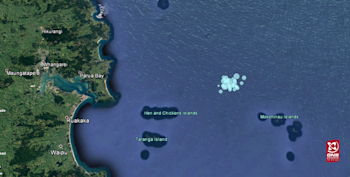National Advisory: Tsunami activity – expect strong and unusual currents and unpredictable surges at the shore following the M8.8 earthquake, Kamchatka Russia. For all information please visit NEMA (The National Emergency Management Agency) Only messages issued by NEMA represent the official warning status for New Zealand.

Earthquake swarm in Northland
GeoNet has registered 39 earthquakes clustered in an area of the Hauraki Gulf to the east of Whangarei since December 26, 2018. The largest of these quakes was a M4.1 on February 10, 2019.
Earthquake swarms are quite common in New Zealand. While they may sound scary, swarms are just a collection of quakes about the same size, happening in a localised area, usually over a short time period (days to weeks). Swarms usually don’t have a mainshock or larger quake that starts off a sequence.
Facts about the Northland swarm:
It started off with an unnoticeable M2.5 quake on Boxing Day at a depth of 5km.
Max depth for quakes in the swarm so far has been 12km. This is considered a shallow swarm.
Of the 39 quakes in the swarm, 10 have been over M3.0
The most felt quake in the swarm was the M4.1 on February 10, 2019 at a depth of 12km. 222 people ‘felt it’.
Because the quakes were centred offshore and at a relatively low magnitude, most of the quakes in the swarm have gone unfelt.
Are quakes in this region normal?
This swarm has come as a bit of a surprise to locals, as this area isn’t known for frequent earthquakes. They don’t happen often, but we have registered earthquakes here before. In 2018 we located more than 19,500 earthquakes across New Zealand – 32 of these were in the Northland/Auckland region. In the last 20 years there have been 75 earthquakes in this region over M3.0 and shallower than 33km.
Could this swarm lead to a larger quake?
While we can’t say that something larger will not happen, by far the most likely scenario is that the level of seismic activity will return to what it was before, i.e. very little seismicity.
Can these quakes cause a tsunami?
It’s unlikely that an earthquake large enough to produce a tsunami would occur in this region. The quakes in this swarm haven’t posed a tsunami threat because they are not big enough.
Are these quakes related to volcanic activity?
Our volcanologists have said it’s highly unlikely that this swarm is volcano or magma-related. The nearest volcanoes are in the Whangarei area, but these have not been active for about 300,000 years. Further east in the Rotorua-Taupo area and offshore around Matata swarms like this are quite common and are the result of rifting/spreading of the north-central North Island.
Are there other swarms happening?
Yes, there is another small earthquake swarm in Lake Taupo happening now.
This small swarm started on January 29 and may still be occurring. We have recorded 33 earthquakes that are large enough to get locations. These earthquakes range in magnitude from 0.4 to 2.6, while the depths ranged between 4 and 7 kilometres for all events except for one event at 14km depth. The events were too small to be widely felt and only weak shaking would have been experienced by the local population.
Swarm activity like this is very typical of earthquake activity in the Taupo Volcanic Zone, and this swarm is like past small swarms in the greater Rotorua-Taupo area.
What can I do?
An earthquake can occur anywhere in New Zealand at any time. All New Zealanders should be prepared in case of a natural disaster-induced emergency. Follow the Ministry of Civil Defence’s guidance on how to make sure that you and your family will get through an emergency, and EQC’s advice on how to secure your household and belongings.


